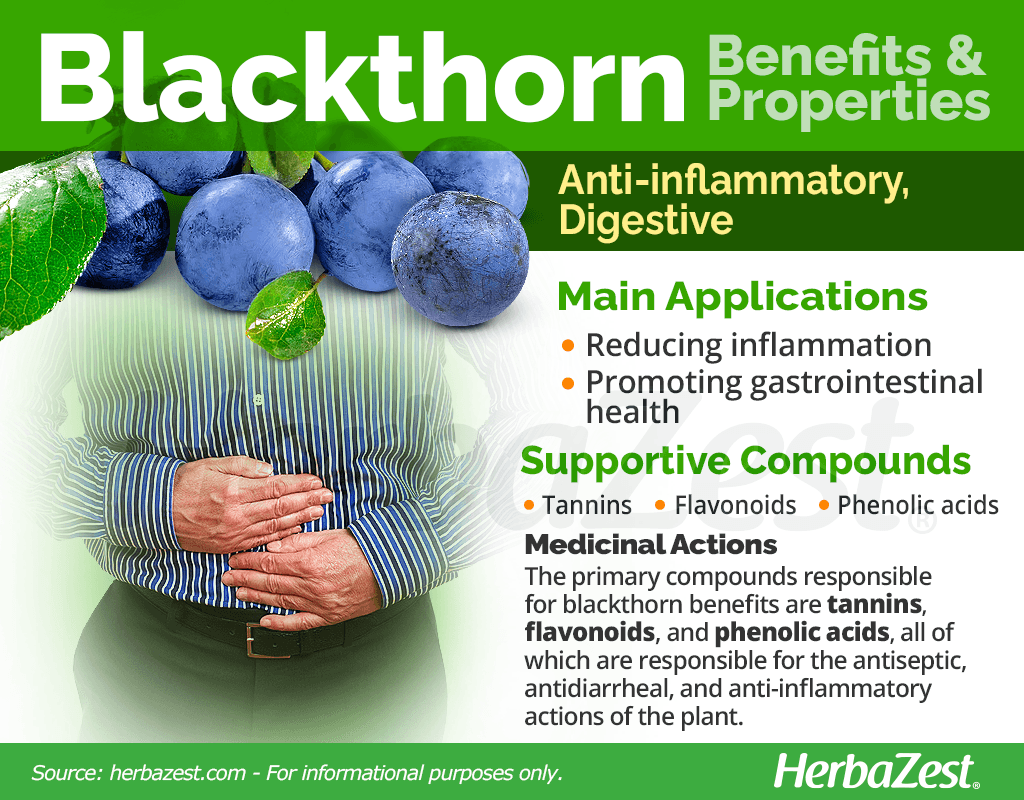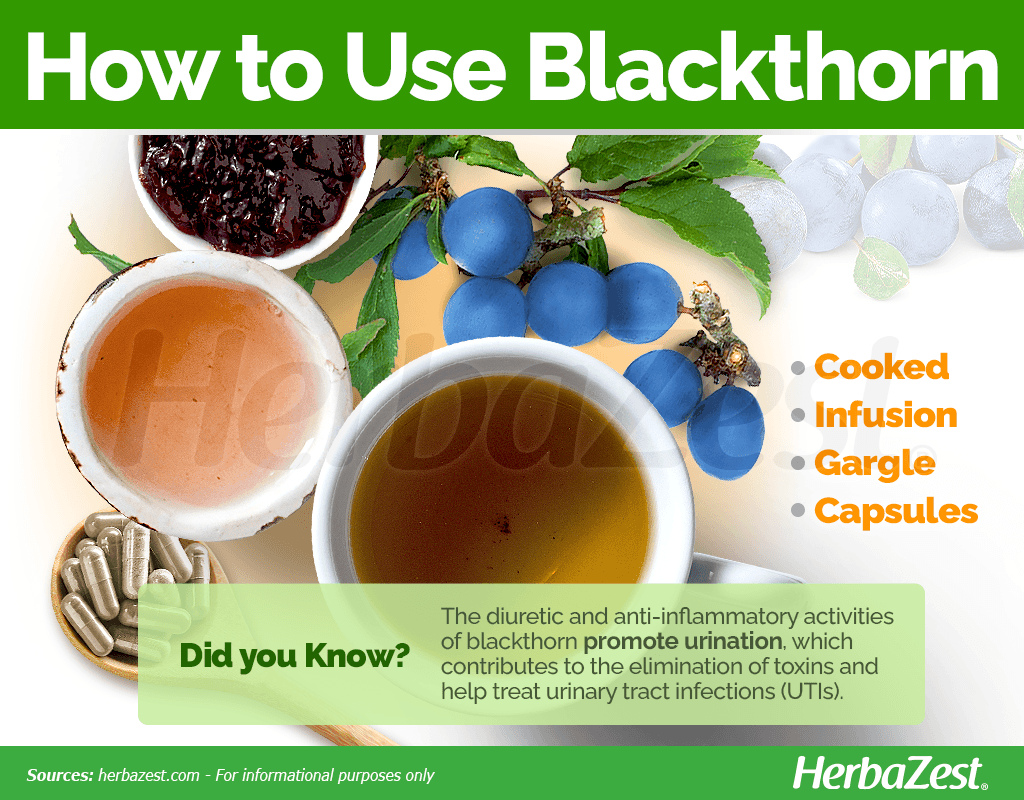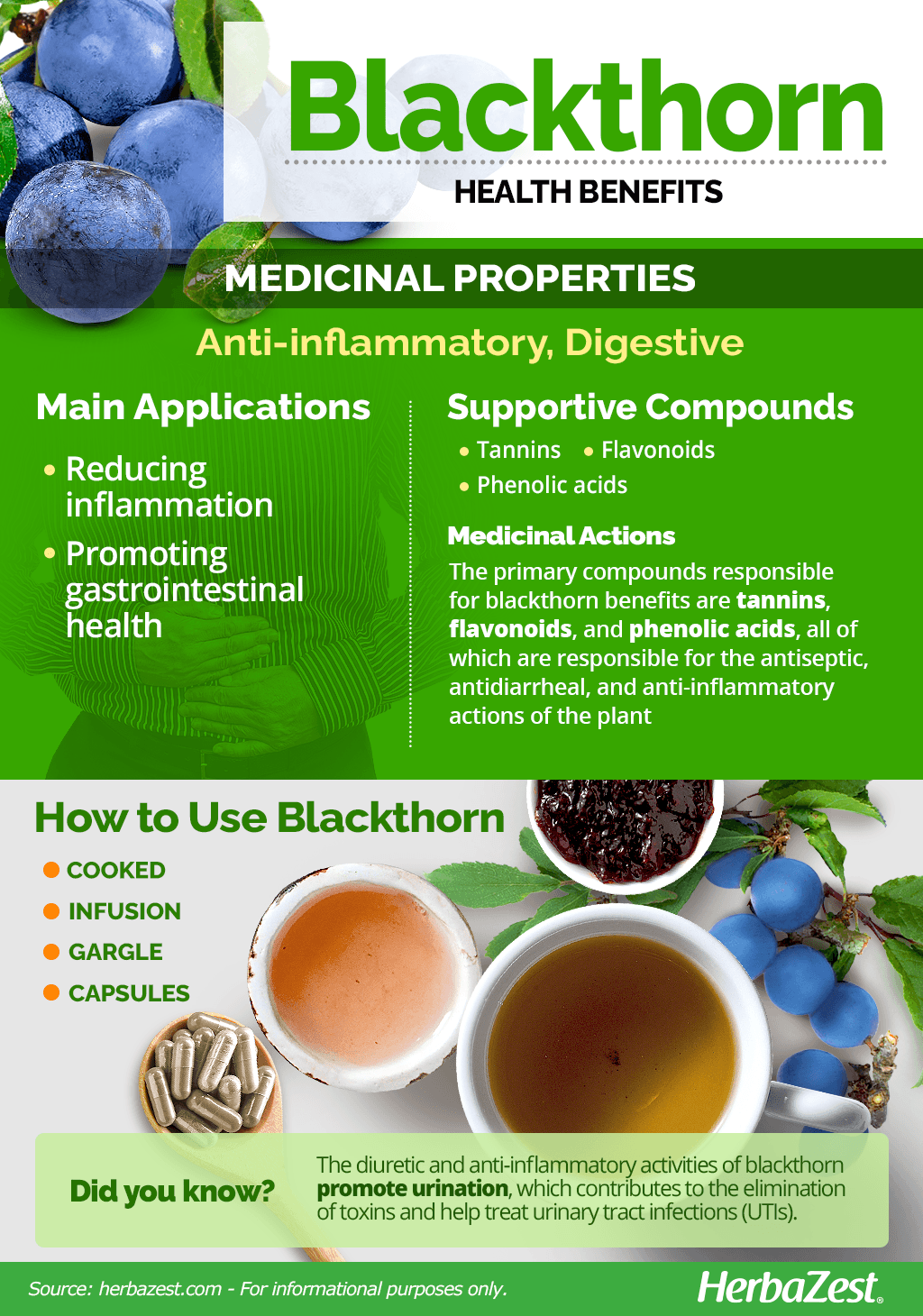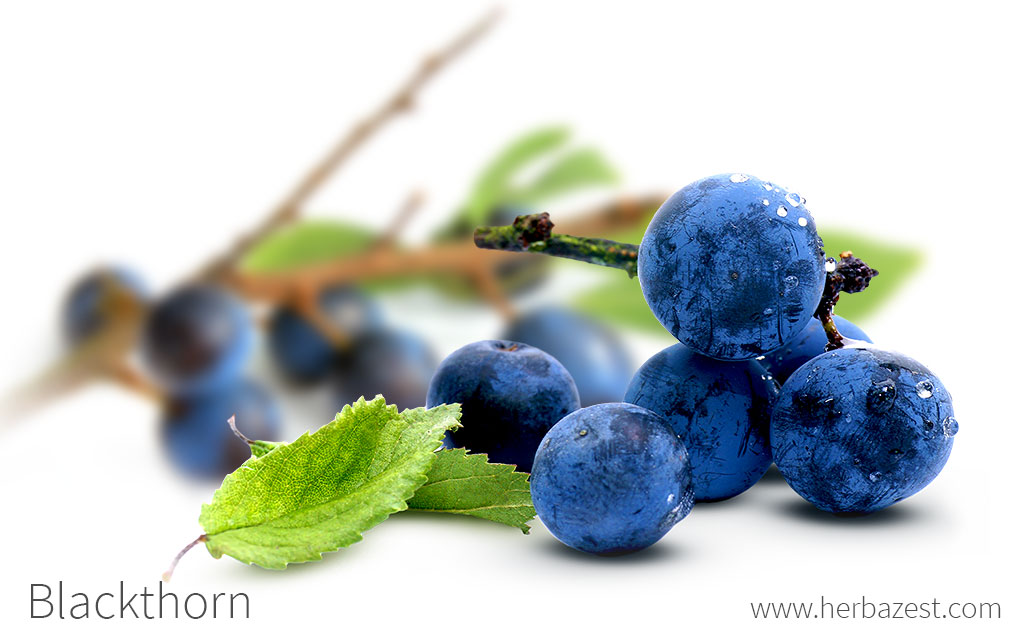Blackthorn, also known as sloe, is native to Europe, western Asia, and northern Africa. Due to its traditional uses, blackthorn has been investigated by science, revealing the mechanisms behind its medicinal properties.
Blackthorn Medicinal Properties
- Medicinal action Anti-inflammatory, Digestive
- Key constituents Tannins, flavonoids, phenolic acids
- Medicinal rating (2) Minorly useful plant
- Safety ranking Safety undetermined
Health Benefits of Blackthorn
Research on this herb has revealed diuretic, laxative, astringent, and anti-inflammatory properties. Blackthorn, or sloe, has been used in medicinal ways for centuries. Its most popular benefits include:
Reducing inflammation. The active compounds in blackthorn have been shown effective for the treatment of inflammatory processes in the mouth and the respiratory system.
Promoting gastrointestinal health. Blackthorn posses both astringent and laxative properties, which make it effective for stopping diarrhea, but also for regulating digestion and relieve constipation.
Additionally, the diuretic and anti-inflammatory activities of blackthorn promote urination, which contributes to the elimination of toxins and help treat urinary tract infections (UTIs).
How It Works
Tannins have strong antiseptic, antidiarrheal, and anti-inflammatory actions.
The primary compounds responsible for blackthorn benefits are tannins, flavonoids, and phenolic acids, all of which are responsible for the antiseptic, antidiarrheal, and anti-inflammatory actions of the plant.
On the other hand, rhamnazin, a natural flavonoid found in plants such as blackthorn, been shown to possess strong antioxidant and anti-inflammatory properties, which inhibit oxidation and protect cells against free radicals.
Rhamnazin has also shown protective properties against inflammation in acute lung injury, inhibiting the metabolism of cytokines, which are proteins secreted by the immune system in order to affect cellular functions.1
Blackthorn fruit extracts have been shown to effectively reduce oxidative stress at a cellular level.2
Other herbs, like garlic, lemon, and onion have been shown to be beneficial for respiratory problems, whereas arracacha, papaya, and sweet potato share similar digestive properties.
Blackthorn Side Effects & Cautions
There are no reported side effects for blackthorn, and the herb is considered safe in recommended amounts. However, as other members of the Prunus family, blackthorn contains cyanogenic glycosides, which are toxic in large quantities, and long-term consumption is not advised. Symptoms of cyanide poisoning include shortness of breath, weakness, light-headedness, seizures, stupor, irregular heartbeat, and cardiovascular collapse, causing coma and death in extreme cases.
Blackthorn can also cause "plant thorn injury", which is caused when the thorns of the bush penetrate clothing, gloves, or shoes, and produce an infection due to their poisonous compounds. Care should be taking when handling the plant.
The oral consumption of blackthorn is contraindicated in women during pregnancy and lactation.

How to Consume Blackthorn
- Edible parts Fruit
- Edible uses Beverage
While blackthorn is more commonly known for its industrial and culinary uses, it can also be consumed in medicinal preparations that concentrate its healing benefits and can be easily prepared at home.
Natural Forms
Cooked. The fruits of blackthorn are commonly used to prepare fruit pies, jams, dyes, and syrups.
Infusion. An infusion can be brewed from one to two grams of dried blackthorn flowers. One or two cups can be taken per day.
Gargle. A blackthorn gargle is made by brewing an infusion of two to four grams of dried fruit. Fresh fruit juice can also be gargled. This is used to reduce mouth and throat inflammation.
Herbal Remedies & Supplements
- Capsules. The dried leaves and berries of blackthorn are finely ground and consumed in these supplemental forms, which offer safe, standardized doses, sparing the herb's bitter flavor.

Growing
- Life cycle Perennial
- Harvested parts Flowers, Fruit
- Light requirements Full sun
- Soil Chalky or lime-rich
- Planting time Summer
- Propagation techniques Cuttings
This thorny shrub, with white flowers and dark branches, is native to Europe and western Asia, but it can also be found in New Zealand and eastern North America. It naturally grows in hedgerows and woodlands, where it can form dense stands. Blackthorn, also known as sloe, is a relatively low-maintenance, slow-growing shrub that is though and resilient once established.
Growing Guidelines
Blackthorn plants can be easily propagated from softwood cuttings or from seed.
The blackthorn bush grows best in full sun and tolerates most soils, as long they are well-drained, except the acidic ones.
It requires moderate water and occasional pruning.
Blackthorn bush naturally spreads by suckers, as well as by bird- or animal-sown seed. Regular weeding is necessary in order to prevent uncontrolled growth.
Additional Information
- Other uses Fuel
Plant Biology
Blackthorn is a woody, deciduous shrub that can grow up to 20 feet (6 m) in height. It is characterized by dull green leaves, white flowers, dark bark, and showy blue-black, spherical fruits. Blackthorn fruits are very similar to plums, a close relative.
Classification
Blackthorn, or Prunus spinosa, is a member of the Rosaceae family, among other economically important species, such as apple (Malus domestica), apricot (Prunus armeniaca), blackberry (Rubus fruticosus), pear (Pyrus communis), and plum or prune (Prunus domestica).
Related Species
There are several species related to blackthorn that are also used medicinally. The most well-known related species are plum (Prunus domestica) and wild cherry (Prunus avium), which were used traditionally for their diuretic and astringent properties. Other relatives of blackthorn are morello cherry (Prunus cerasus) and black cherry (Prunus serotina).
Historical Information
The history of this bushy tree is rooted in the United Kingdom, as blackthorn plants were traditionally used as a "cattle-proof" hedge to keep the cattle inside the perimeter of the land. Blackthorn was also commonly used as a wind and snow screen for land because of its density. After blackthorn charcoal and its fruit seeds were found in an archaeological site near Dublin, it has been argued that the herb's use dates as far back as the 13th century.
Economic Data
Blackthorn, or slow, is widely used to make a variety of products, but its main economic value lies in the food and beverage industry. The high economic value of blackthorn can be attributed to the commercial sale of the raw and its wide use in making gin, wine, preserves, and various desserts. China leads the world production, yielding over 6 million tons in 2012.
Other Uses
Alcohol industry. Blackthorn is most well-known for its common use in making gin, most commonly called sloe gin. Wine, juice, and cider are also beverages commonly flavored with blackthorn.
Timber. Blackthorn wood is especially hard and it has been used to make walking sticks. A 'shillelagh' is a highly polished stick of blackthorn wood that was made and used in Ireland for self defense and it is now used in a form of traditional fighting or martial art.
Living fence. Widely grown as a hedge plant, blackthorn can also act as a 'nurse plant', allowing other plants to develop protected from possible damage by grazing animals. The shrub is also used to keep cattle within property lines.
Fuel. Blackthorn bark makes good firewood because it burns slowly and provides ample heat.
Sources
- American Herbal Products Association's Botanical Safety Handbook, p. 708
- Botanical Safety Handbook, p. 93
- Kew Royal Botanical Gardens, Kew Science - Plants of the World Online - Prunus spinosa L.
- Oxford Desk Reference: Toxicology, pp. 321
- RSPB Handbook of Garden Wildlife, p. 204
- The History of British Flora, p. 196
- University of California, Agriculture and Natural Resources - Poisonous Plants
- Woodland Trust - UK, Blackthorn (Prunus spinosa)
- FAOSTAT
- Medicinal Plants of the World, p. 257
- Germplasm Resources Information, Taxon: Prunus spinosa L.
- Kew Royal Botanic Gardens, Kew Science, Plants of the World Online, Prunus spinosa L.
- Ohio State University, Extension - Avoiding Skin Irritations and Injuries Caused by Plants
Footnotes:
- African Journal of Traditional, Complementary, and Alternative Medicines. (2017). Antioxidant and Anti-Inflammatory Effects of Rhamnazin on Lipopolysaccharide-Induced Acute Lung Injury and Inflammation in Rats. Retrieved February 14, 2024, from: https://www.ncbi.nlm.nih.gov/pmc/articles/PMC5471467/
- Nutrients. (2023). Nrf2-Mediated Pathway Activated by Prunus spinosa L. (Rosaceae) Fruit Extract: Bioinformatics Analyses and Experimental Validation. Retrieved February 14, 2024, from: https://www.ncbi.nlm.nih.gov/pmc/articles/PMC10181019/





